“It’s not what you look at that matters, it’s what you see.”
- American philosopher Henry David Thoreau
Voting in Malaysia is primarily discussed and understood through ethnic lenses. This was especially the case for GE15, where voting was highly racially polarised after a highly racialised campaign.
Yet in Malaysia’s complex and diverse society, there are other equally important dynamics shaping political engagement, determining whether people come out to vote and who they support.
This four-part series looks at voting in GE15 through four other valuable socio-economic frameworks – gender, generation, geography (urban-rural), and class.
The findings show that to better understand GE15, and more generally how citizens engage in politics, one needs to bring in multiple analytical tools, to appreciate other social (and political) cleavages.
This ‘looking beyond’ analysis finds surprising overlooked and misunderstood shifts in voting behaviour, many of which challenge mainstream assumptions of GE15.
A gender lens
Perhaps of all the most prominent differences, the least discussed is gender.
When looking at gender, traditionally the attention is on female candidates; attention is rightly drawn to the fact that while 13.5 percent of all candidates fielded were women, only 30 women won seats in Parliament, down from 33 in GE14.
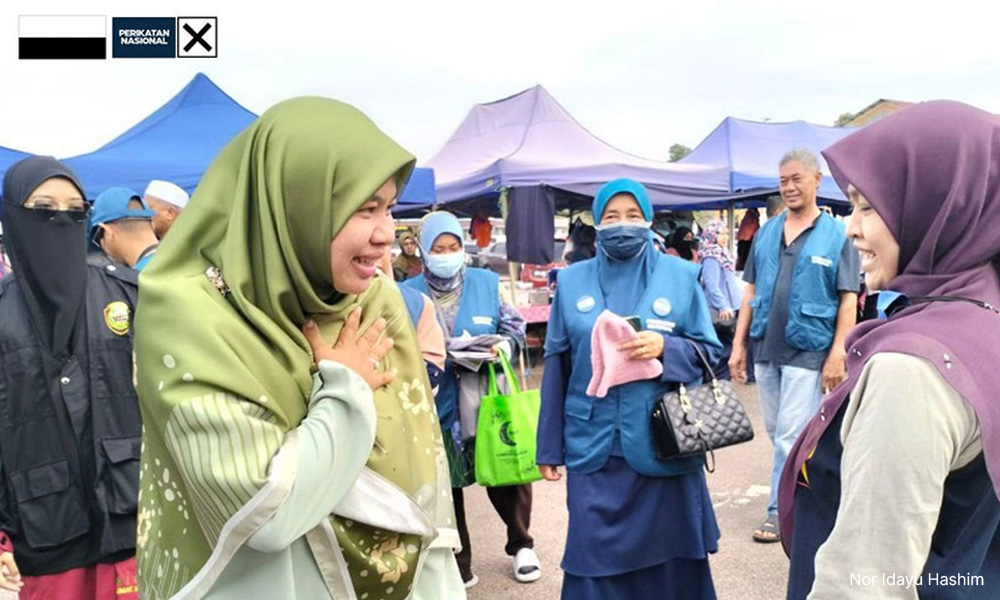
Women candidates in GE15 were not only disproportionately defeated, but they were also displaced by competition against other women or placement in less winnable seats.
Attention to the political behaviour of women voters generally is less highlighted. My earlier piece on gender voting trends pre-GE15 is an exception.
This first in a series examining GE15 voting behaviour beyond ethnicity continues research on how women and men voted and draws out implications for current politics.
The analysis finds striking differences and swings in how men and women voted in GE15, from who turns up to vote and who they vote for.
The methodology is similar to that of the earlier study of ethnic voting, ecological inference assessed at polling station levels yielding an estimate of voting.
Gender is more challenging to assess, however, as men and women usually are evenly split into the various polling stations.
To glean a more reliable estimate, the analysis includes the different ethnic compositions of men and women in the various polling stations to capture more variance along gender.
With more data points of different gender compositions to compare, it is possible to estimate voting by gender.
The analysis was supported by pre- and post-focus groups to understand the findings. Note that this study looks at all of Malaysia, so it does not differentiate between Peninsular Malaysia and Borneo.
Gender turnout gap narrows: More men stayed home
The estimates yield fascinating findings. First, we find that disproportionately more men stayed home.
In understanding turnout broadly, regarding the drop from GE14 to GE15, the focus has been on the impact of including more voters through automatic registration and the higher drop in turnout among Chinese voters.
A gender lens offers different insights, showing that it was men who were more likely not to vote, an estimated drop in participation of (a significant) 15 percent.
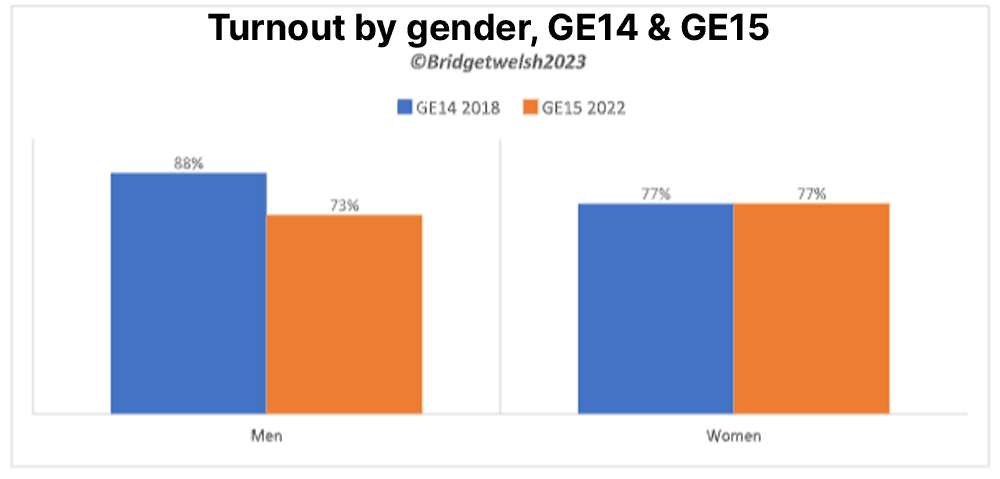
GE14 brought more men out compared to earlier elections, but in GE15 this was reversed.
Part of this is clearly tied to economic conditions, Covid-19, and an inability to go back to vote due to financial considerations, as men disproportionately are more outstation than women. Economic realities of making a living predominated over returning to vote.
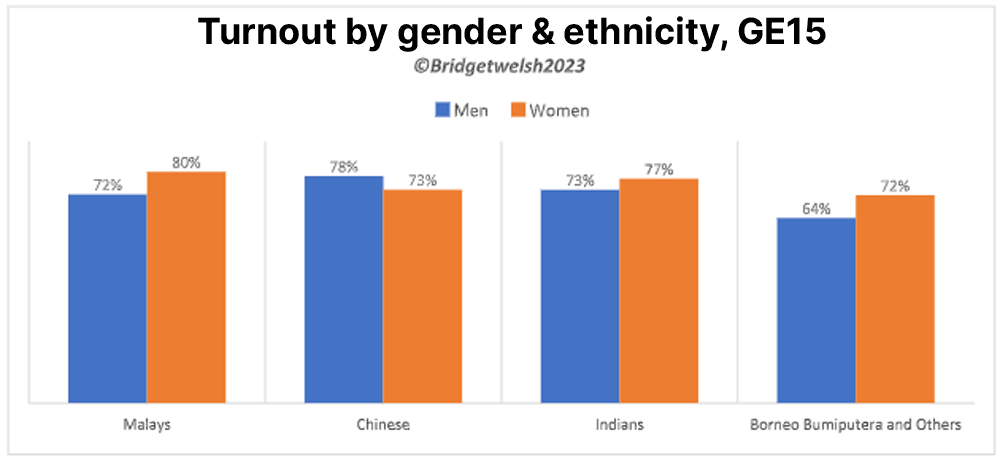
Yet, given the size of the drop in male turnout, other factors were going on. Here, a combination of ethnicity and gender analysis of turnout provides insight, as the largest gender gap and swings in voting along gender lines were among Malays and Bumiputera in Borneo.
Unlike the excitement of GE14, the promise of change and new governance, greater realism and disappointment with options underscored why more men stayed home.
Rather than vote against Umno, for example, more Malay men, for example, did not vote.
In contrast, women came out to vote. The turnout findings show women engaged at levels on par with men in GE15 and similar to levels in GE14. They were consistent participants in the past two general elections.
In fact, the gender gap in turnout disappeared in GE15, with women coming out slightly more than men, an estimated three percent more.
PN female boost: Women swing in support
A consistency in engaging politically however cannot be confused with political loyalty. Women – not men – were the most likely to change who they supported in GE15.
The findings show that Perikatan Nasional (PN) gained an estimated (whopping) 22 percent of support among women; one in five women voters supported PN.
The mainstream view is that PN gained seats because of younger voters. (The next in this series will look at generation factors.) A gender lens shows that PN gains were driven by the support primarily of women. By comparison, male support for PN only increased an estimated five percent.
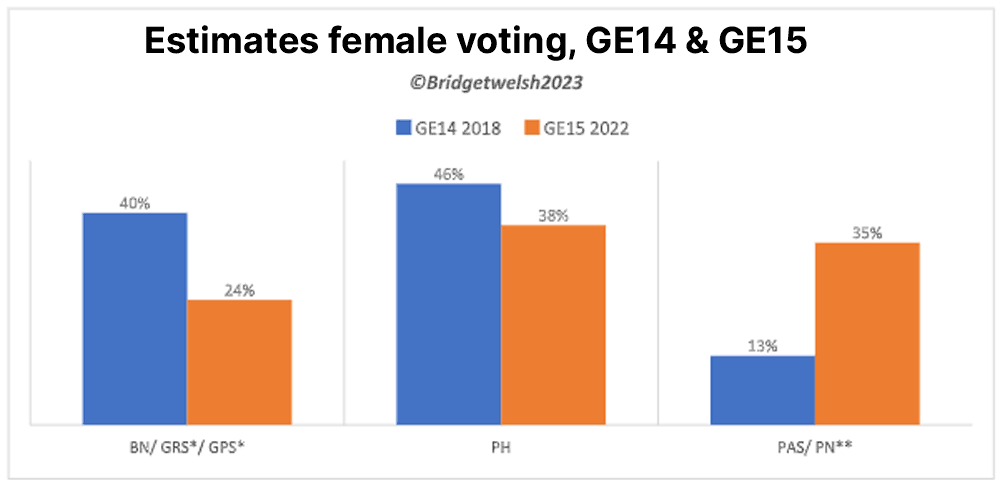
This PN gain in support among women has been ongoing, as shown in my previous analysis of state elections. A closer look at this gain shows that this support is predominantly concentrated among Malay women.
Subsequent focus groups highlight four main drivers:
1) Weak engagement of women by other political alternatives. Wanita Umno’s strength is not what it was in the past, for example. Pakatan Harapan’s campaign ignored women on the ground in many areas altogether.
2) High support for PN’s ‘Abah’ factor, focusing on greater social assistance during Covid and focus on social assistance garnering support.
3) Intense dislike of the bully tactics of Umno president Ahmad Zahid Hamidi in GE15.
4) Finally, the greater appeal of PN’s GE15 campaign focus on stability. Women voters were less attracted to the destabilising political infighting and jockeying that shaped Harapan 1.0 and Umno’s governance after 2018; the noisy political gamesmanship of the boys was rejected as the focus was on securing the welfare and wellbeing of the family. It remains to be seen how women see the post-GE15 PN political destabilising tactics in their role as opposition. Importantly, focus group findings found that support for PN was not associated with greater religious conservatism of women compared to men, although this is an area in need of further study.
Both Harapan and Umno’s support among women declined over the past two general elections, by an estimated eight percent and 16 percent respectively.
While disproportionately, the female shift in voting largely came from an erosion of support for Umno, the declines show that two of the main coalitions in the Anwar Ibrahim government had a gender gap in support in GE15.
Harapan’s lower level of support among women extends across ethnic communities. For example, only an estimated six percent of Malay women voted for Harapan nationally.
Harapan’s support also dropped among men. A look at support patterns of men in GE15 find that the largest swing was in support for Harapan, an estimated 11 percent. By comparison, male support for the other coalitions remained largely the same.
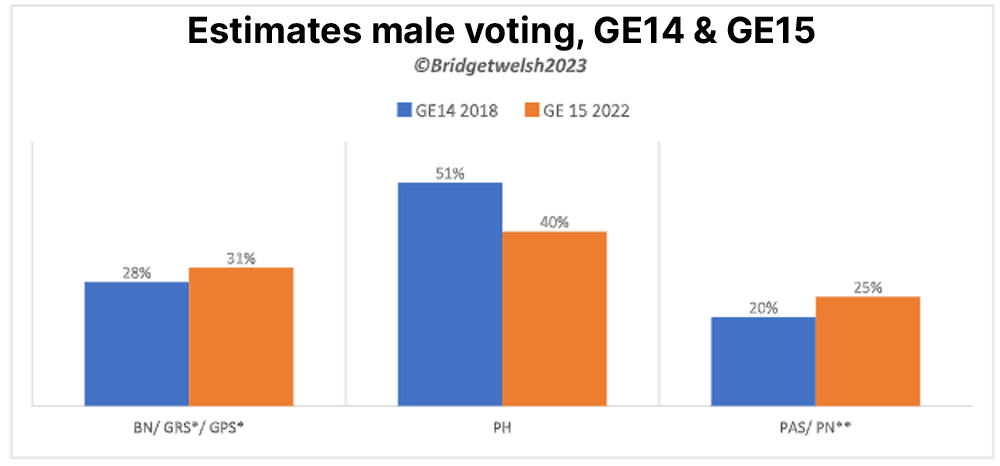
Rethinking gender voting
Adopting a gender lens suggests a need to rethink what happened in GE15.
The PN victory was shaped by women changing political support from the other coalitions and continuing to vote at high levels. Men, rather than change their loyalties in support, did not vote in higher numbers.
In the five months of the Anwar government, the focus has been on increasing female representation at the ministerial levels, passing bills on stalking (which disproportionately impacts women), strengthening child protections, and increasing social assistance broadly – all meaningful changes.
The framework to look at gender in the Anwar government has been built on measures in process for some time, especially legal reforms.
There is a predominant view that greater support from women will come from reforms and elite female representation. There is yet a clear programme that improves the conditions for women more broadly.
The GE15 findings suggest that winning electoral support needs to go beyond the initiatives to date. The GE15 gender voting analysis shows that attention to welfare, better governance, and stability matters – that women want the government to focus on the job at hand – and that ordinary women expect more deliverables from the government.
Consistently in their high participation and emphatically in shifting political loyalties, women are shaping electoral outcomes. Women’s voting behaviour proved to be decisive in the GE15 results – yet another reminder that ignoring women and the concerns of women comes with political peril. - Mkini
BRIDGET WELSH is an honorary research associate of the University of Nottingham, Malaysia’s Asia Research Institute (Unari). She is also a senior research associate at the Hu Fu Centre for East Asia Democratic Studies and a senior associate fellow of The Habibie Centre. Her writings can be found at bridgetwelsh.com.
The views expressed here are those of the author/contributor and do not necessarily represent the views of MMKtT.



No comments:
Post a Comment
Note: Only a member of this blog may post a comment.